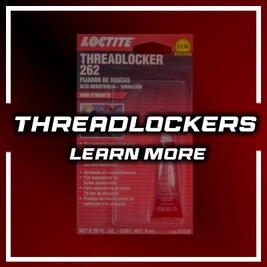An Introductory Guide to Threadlockers
Threadlockers are an essential tool for any serious DIYer or mechanic. They are used to secure nuts and bolts against vibration, allowing them to stay together without the need for additional tightening. If you’re new to threadlocking, this guide will provide you with an introduction to what threadlockers are and how they work.
Types of Threadlockers
Threadlockers come in a variety of different formulas, so it’s important to know which one is best for your application. The most common types of threadlockers are red, blue, and green. Red threadlocker is the strongest formula and is designed for high-vibration applications like engines and transmissions. Blue threadlocker is medium strength and is typically used on applications that require frequent disassembly. Finally, Green threadlocker is the weakest formula and is used on applications that don't require as much vibration resistance but still need a secure fitment.
Purple threadlocker is best suited for projects that use light fasteners and require a torque of up to 55 foot lbs for their disassembly. As it is relatively easy to break the bond, this type of threadlocker is often preferred for operations that may involve regular dismantling and reassembling. Furthermore, purple threadlocker works well with metal, plastic, or even rubber fasteners, making it an extremely versatile product. Ideal for lower-strength applications such as mounting smaller parts in machinery, hobbyists also rely on this type of purple thread lockers for various DIY projects to ensure parts do not come loose over time.
Blue threadlockers are highly valuable for their strong bond, requiring up to 100 ft lbs of torque to break the seal. This makes them an ideal choice for those looking for a more secure connection between parts than traditional threading methods provide. For users with applications involving high heat, medium lockers can be used that can withstand temperatures up to 300 degrees or higher. Additionally, blue threadlockers have the added benefit of being considered "removable," as they can still be taken apart in the future despite their powerful adhesive qualities. This makes them a great choice when a long-term bond is desired, but it remains important that the parts must be able to be disassembled when required.
Red threadlocker provides a great solution for applications requiring variable torque and heat capacities. It offers an impressive 275 ft lbs of torque thanks to its general purpose red locker, and with the help of higher temperature versions that are available up to 650 degrees, it can be used in various delicate scenarios. The ultra-high temperature version is especially effective in applications that require extremely high temperatures and might go up to 450 degrees. Red threadlocker is the perfect option for anyone looking for high performance with adjustable temperatures.
Green threadlockers offer a versatile and reliable solution when it comes to securing components that can't be pre-assembled. These products come in a variety of strengths and are suitable for use on places such as electrical terminals, accessories etc. They can also provide protection for sleeve retainers, studs, and even hairline cracks by creating an airtight seal that can hold up against temperature extremes or vibrations. In this way, green threadlocks allow users to keep parts safely connected with confidence in the knowledge that their components are secure.
Application Process
The application process for threadlocking depends on the type of product being used. Generally speaking, red threadlocker should be applied directly onto the threads of the fastener after it has been tightened down by hand (or with a torque wrench). Once applied, let the red thread locker set up overnight before use. Blue and green thread lockers typically come pre-applied on fasteners from the factory—simply tighten them down as usual with a torque wrench or other tool as instructed by your product manual or service manual.
Storage Considerations
When storing threaded fasteners with any form of threadlocker applied, always store them in their original packaging or in labeled containers so you can easily identify them later if needed. Additionally, make sure you keep them in a cool dry place away from direct sunlight as extreme temperatures can cause the thread lockers to break down over time which can lead to loosening of fasteners during use or installation.
Threadlocker is an innovate tool for ensuring easy assembly and ultimate protection against corrosive elements. Its anaerobic adhesive bonds fasteners together, sealing threads and preventing rust, corrosion, and leaks. With it, loose screws are a thing of the past! This sealant is a valuable addition to any Handyman's toolbox as it provides a secure bond on nuts, bolts and screws in all sorts of applications. Threadlocker is also ideal for high-performance machines that vibrate or are frequently disassembled. Therefore, DIYers and professionals alike rely on this unique product for efficient projects with guaranteed results.
Whether you’re working on cars, motorcycles, bicycles or just around your home workshop – using a quality Thread Locker ensures that nuts & bolts remain secured against vibration & shock loads at all times! This guide provides an introductory overview into what Thread Lockers are, types available and how they should be stored - making it easier for DIY'ers & mechanics alike to understand & use this essential product! With this knowledge in mind you'll have no trouble getting your projects done quickly & securely!
Recent Posts
-
Ford 363 Crate Engine Specs: A Complete Guide
Ford 363 Crate Engine: A Deep Dive Into 500+ HP When you're searching for the heart of your next pr …Nov 5th 2025 -
Pro Dirt Bike Suspension Explained: Brands, Tech & Costs
Pro Dirt Bike Suspension: A Racer's Guide When you watch a pro dirt bike racer float over whoops o …Oct 27th 2025 -
Dirt Bike Tracks in Michigan
Your Ultimate Guide to Michigan's Dirt Bike Tracks Michigan offers a thrilling landscape for dirt bi …Oct 24th 2025




